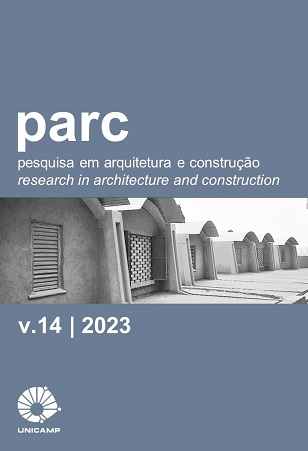Abstract
This research compares potential movement and permanence configured by space with actual flows and experiences in the Humanistic Sector (Campus I, Universidade Federal da Paraiba, UFPB). The study started from the observation that some spaces of the Humanistic Sector, although with similarly built typologies, are characterized differently, such as the “Happiness square”. Understanding that collective spaces can provide everyday relief and spontaneous encounters between people and that spatial form can facilitate or hinder encounters, spatial patterns of potential movement, encounters and views of spaces between the Humanistic Sector classrooms are compared based on the Social Logic Theory of Space, or Spatial Syntax, framework. These patterns were compared with movement and stationary activities observed in field surveys, mapping flows and peoples’ activities and profiles at different locations. Spaces more central and closer to easier access circulation exhibited diverse uses and more women in contrast with less visible and less integrated spaces, with more introspective and quiet behavior. Results reveal an internal spatial hierarchy and the connection with the campus access characterizing diverse spaces with complementary uses contributing to interactions and relief in academic life. Future investigations can evaluate the possible benefits of these uses in learning.
References
AL-SAYED, K.; TURNER, A; HILLIER, B. PENN. A. Space Syntax Methodology: Bartlett School of Graduate Studies. London: University College London, 2014.
BOAVENTURA, F. Padrão especial e dimensão humana dos espaços de prática social no Campus I da UFPB: Estudo do Quarteirão do Conjunto Humanístico. João Pessoa. 2020. 152 f. Dissertação (Mestrado em Arquitetura e Urbansimo) – Centro de Tecnologia, Universidade Federal da Paraíba.
CAMPOS, B. A.; GOLKA, T. Public spaces revisited: a study of the relationship between patterns of stationary activity and visual fields. In: SPACE SYNTAX INTERNATIONAL SYMPOSIUM, 5., 2005, Amsterdam. Proceedings [...]. Amsterdam: Delft, 2005. p. 545–553.
COELHO, C. D. Os elementos urbanos. Lisboa: Argumentum, 2014. 208 p. (Cadernos de Morfologia Urbana. Estudos da cidade portuguesa, v. 1).
DONEGAN, L. Qual é a sua praia? Arquitetura e Sociedade em Natal. Brasília: FRBH, 2019.
GEHL, J. Cidade para Pessoas. São Paulo: Perspectiva, 2013. 280 p. (Arquitetura/Arq).
GEHL, J.; SVARRE, B. Vida na Cidade: como estudar. São Paulo: Perspectiva, 2018. 184 p.
GRANOVETTER, M. S. The Strength of Weak Ties. American Journal of Sociology, v. 78, n. 6, p. 1360–1380, May 1973.
HAN, S.; SONG, D.; XU, L.; YE, Y.; YAN, S.; SHI, F.; ZHANG, Y.; LIU, X.; DU, H. Behaviour in public open spaces: A systematic review of studies with quantitative research methods. Building and Environment, v. 223, Sept. 2022. DOI https://doi.org/10.1016/j.buildenv.2022.109444.
HANSON, J. Decoding Homes and Houses. Cambridge: Cambridge University Press, 1998.
HILLIER, B. Space is the machine: a configurational theory of architecture. London: Space Syntax, 1996.
HILLIER, Bill; HANSON, J. The social logic of space. Cambridge: Cambridge University Press, 1984.
HILLIER, Bill; IIDA, S. Network and psychological effects in urban movement. In: COHN, A. G.; MARK, D. M. Spatial Information Theory: COSIT 2005. Lecture Notes in Computer Science. Berlin: Springer, 2005. v. 3693.
HILLIER, Bill; PENN, A.; HANSON, J.; GRAJEWSKI, T.; XU, J. Natural Movement - or, configuration and attraction in urban pedestrian movement. Environment and Planning B: Planning and Design, v. 20, n. 1, p. 29–66, July 2016. DOI: https://doi.org/10.1068/b200029.
HILLIER, Bill; PENN. A. Visible Colleges: Structure and Randomness in the Place of Discovery. Science in Context, v. 4, n. 1, p. 23–50, 1991. DOI: https://doi.org/10.1017/S0269889700000144.
HILLIER, Bill; VAUGHAN, L. The city as one thing. Progress in Planning, v. 67, n. 3, p. 205–230, 2007. DOI: https://doi.org/10.1016/j.progress.2007.03.001.
HOLANDA, F. 10 mandamentos da arquitetura. Brasília: FRBH, 2013.
HOLANDA, F. O espaço de exceção. Brasília: EdUnB, 2002. 466 p.
JENS, K.; GREGG, J. S. How design shapes space choice behaviors in public urban and shared indoor spaces- A review. Sustainable Cities and Society, v. 65, p. 102592, Feb. 2021. DOI: https://doi.org/10.1016/j.scs.2020.102592.
KARIMI, K. A configurational approach to analytical urban design: ‘Space syntax’ methodology. URBAN DESIGN International, v. 17, n. 4, p. 297–318, Sept. 2012. https://doi.org/10.1057/udi.2012.19.
LOPES, F. M.; TRIGUEIRO, E.; DONEGAN, L. Shifting places and community life? Comparing Morphology and Uses after a Community Reallocation from a favela to a Housing Estate in Natal/RN, Brazil. In: INTERNATIONAL SPACE SYNTAX SYMPOSIUM, 11., 2017, Lisboa. Proceedings [...]. Lisboa: Instituto Superior Técnico, 2017.
MAZUR, E. Peer Instruction: A Revolução da Aprendizagem Ativa. Porto Alegre: Penso, 2015. 272 p.
SAILER, K. The Spatial and Social Organisation of Teaching and Learning: The case of Hogwarts School of Witchcraft and Wizardry. 2015. In: INTERNATIONAL SPACE SYNTAX SYMPOSIUM, 10. 2015, London. Proceedings [...]. London: Space Syntax Laboratory, Bartlett School of Architecture, 2015. p. 34.
SARMENTO, B. R. A qualidade ambiental de espaços livres em campi: um estudo na UFPB e UFRN sob a ótica da avaliação pós-ocupação. 2017. 329 f. Tese (Doutorado em Arquitetura e Urbanismo) – Centro de Tecnologia, Universidade Federal do Rio Grande do Norte, Natal, 2017.
SOARES, M.; GROSSKOPF, G. G.; ELI, J. R.; SABOYA, R. T.; BARTH, F. O ambiente construído e a ocorrência de crimes: uma análise em estacionamentos de campus universitário. PARC Pesquisa em Arquitetura e Construção, v. 8, n. 2, p. 102–116, 30 jun. 2017. DOI: https://doi.org/10.20396/parc.v8i2.8649893.
TURNER, A.; DOXA, M.; O’SULLIVAN, D.; PENN, A. From isovists to visibility graphs: a methodology for the analysis of architectural space. Environment and Planning B: Planning and Design, v. 28, n. 1, p. 103–121, Feb. 2001. DOI: https://doi.org/10.1068/b2684.
WHYTE, W. H. City: Rediscovering the Center. Philadelphia: University of Pennsylvania Press, 2009. 408 p.
WHYTE, W. H. The Social Life of Small Urban Spaces. New York: Project for Public Spaces, 1980.

This work is licensed under a Creative Commons Attribution 4.0 International License.
Copyright (c) 2023 PARC Pesquisa em Arquitetura e Construção


